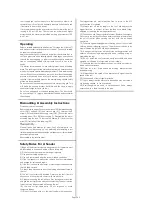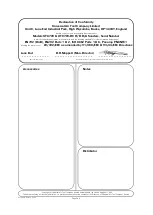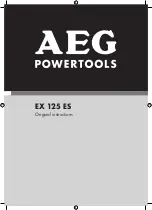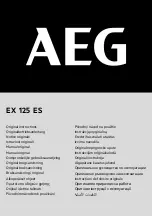
Page No 2
Safety Rules For A Sander
1) Read all the instructions before using this tool. All operators must
be fully trained in its use and aware of these safety rules.
2) Do not exceed the maximum working air pressure.
3) Use personal safety equipment.
4) Use only compressed air at the recommended conditions.
5) If the tool appears to malfunction remove from use immediately
and arrange for service and repair.
6) If the tool is used with a balancer or other support device ensure
that it is fixed securely.
7) Always keep hands away from the working attachment fitted to
the tool.
8) The tool is not electrically insulated. Never use the tool if there is
any chance of it coming into contact with live electricity.
9) Always when using the tool adopt a firm footing and/or position
and grip the tool firmly to be able to counteract any forces or reaction
forces that may be generated whilst using the tool.
10) Use only correct spare parts. Do not improvise or make
temporary repairs.
11) Do not lock, tape, wire, etc. the on/off valve in the run position.
to air supply and run tool slowly for a few seconds to allow air to
circulate the oil. If tool is used frequently lubricate on daily basis and
if tool starts to slow or lose power.
It is recommended that the air pressure at the tool whilst the tool is
running is 90 p.s.i./6.3 bar. The tool can run at lower and higher
pressures with the maximum permitted working air pressure of 100
p.s.i./7 bar.
Operating
Select a suitable abrasive disc (see Section "Foreseen use of the tool")
and make sure that it is fixed securely to the tool. Connect to suitable
air supply as recommended.
Apply the sander lightly to the work and allow the abrasive disc to
cut. Take great care when sanding around sharp edges and surfaces
to avoid the disc snagging i.e. the disc may be brought to an abrupt
stop or considerably slowed that will cause the tool to kick in the
hands.
It is always recommended to use safety glasses and a breathing
mask. The sanding of certain materials may create a hazardous dust
which may require special breathing equipment. Check before using
the tool. Even if the machine has a low noise level the actual sanding
process may cause a noise level such that ear protectors will be
required. If there are sharp areas on the material being sanded safety
gloves are recommended.
Do not continue to use abrasive discs that are worn or clogged. This
will make the sanding process inefficient and the need to apply
unnecessarily high forces to the tool.
Do not use undersized or oversized sanding discs. The disc should
be no more than 1/4" larger in diameter that the pad, and not smaller
than the pad.
Dismantling & Assembly Instructions
Disconnect the tool air supply
Remove abrasive paper. Push service wrench (43) between housing
cover (38-1) and pad (41). and remove pad (41). Unscrew the 4
screws (39) and remove the housing cover (38-1). Pull out the motor
assembly parts (19 to 36) from housing (1). Disassemble the motor
assembly step by step. To remove the bearing (21) from the rear
plate (22) first take off the snap ring (20).
Reassembly
Clean all parts and examine for wear. Coat all metal parts in a
pneumatic tool lubricating oil, one preferably incorporating a rust
inhibitor, and grease all bearings with a molybdenum or lithium based
general purpose grease.
Reassemble in the reverse order.
The trigger/lever etc. must always be free to return to the 'off'
position when it is released.
12) Always shut off the air supply to the tool, and depress the
trigger/lever etc. to exhaust air from the feed hose before fitting,
adjusting or removing the working attachment.
13) Check hose and fittings regularly for wear. Replace if necessary.
Do not carry the tool by its hose and ensure the hand is remote from
the on/off control when carrying the tool with the air supply
connected.
14) Take care against entanglement of moving parts of the tool with
clothing, ties, hair, cleaning rags, etc. This will cause the body to be
drawn towards the tool and can be very dangerous.
15) It is expected that users will adopt safe working practices and
observe all relevant legal requirements when installing, using or
maintaining the tool.
16) Do not install the tool unless an easily accessible and easily
operable on/off valve is incorporated in the air supply.
17) Take care that the tool exhaust air does not cause a problem or
blows on another person.
18) Never lay a tool down unless the working attachment has
stopped moving.
19) Always check the speed of the attachment is higher than the
speed of the tool.
20) Check speed of tool at regular intervals.
21) Check always that the material to be sanded may not cause a
risk by being sanded, i.e. fire or explosion.
22) If self fixing discs are used, i.e. self adhesive or Velcro, always
ensure the disc is fixed centrally to the pad.






















